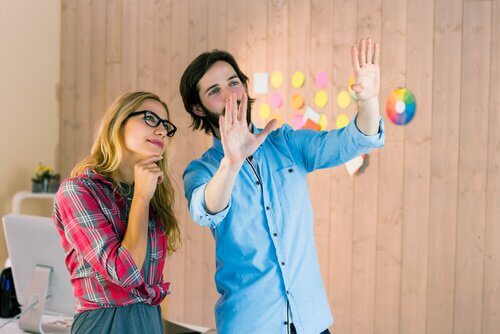Is Creativity Innate or Learned?

When you think of creativity, the idea of a muse inspiring a “chosen one” into creating marvelous works of art may come to your mind. However, many people wonder whether creativity is innate or learned. But although it manifests spontaneously in some human beings, others have trained themselves through an organized process to make the most out of it. Thus, to answer the above question: yes, anyone can learn creativity.
The term “creativity” was coined by Joy Paul Guilford over 50 years ago. According to him, creativity is the ability to do something new and valuable. This idea applies to anything a person does. Thus, anyone can be creative when it comes to solving problems or formulating a theory, among other things.

Is creativity innate or learned?
Few experts doubt that the ability to be creative is intrinsic to all people to a greater or lesser extent.
Many authors believe that, beyond the level of departure or genetic predisposition, everyone can learn to be original, flexible, and sensitive. Every human can acquire the fundamental skills to be creative. Thus, creativity is sensitive to experience and the challenges one faces drive and reinforce it.
Likewise, other authors argue that all children are creative by nature. Researchers know that children undergo a stage of constant formulation of questions and divergent thinking between the ages of three and five. This is a phase characterized by a creativity they can maintain for life under an appropriate reinforced environment. Thus, these authors believe that creativity is innate. Unfortunately, many people lose this skill as the years go by.
Be that as it may, and even if it is a complex process, a person can train themselves to be creative. Similarly, everything you can learn can be taught. Thus, the fundamental thing is to develop creative attitudes such as imagination, curiosity, and criticism. In addition to self-confidence, proactivity, frustration management, and perseverance.
“Creativity is contagious. Pass it along.”
-Albert Einstein-
When it comes to creativity, the following should be taken into account:
- It should be taught from the interests of the individual and taking their abilities into account.
- Teachers must use simulation, consultation and discovery methods.
- Also, there must be stimulation of imagination and curiosity in a basic way throughout the training.
- Teaching must encourage the integrated use of different materials, ideas, methods, and means.
- In addition, it must explore, investigate, and experiment. Basically, find new challenges and discover needs and resources.
- It must promote self-assessment and self-criticism, with the aim of determining if the result is useful and valuable.
- Also, it must acquire the specific knowledge that’s useful for the creative process.
- Creativity is determined by motivation and effort.
- You have to acquire basic skills such as language, problem-solving and goal orientation.
- Also, you must trust yourself and foster the expression of your ideas.
- Finally, there must be opportunities to launch creative processes, balanced in freedom and structure.

What impairs creativity?
In addition to teaching creativity through a series of guidelines, keep in mind that other factors can hamper creativity.
Likewise, people’s experiences may have reinforced or taught schemes in which other ways of acting or expression weren’t valid. In this regard, you must focus on the importance of the result and on the added value of following a creative process.
Secondly, extrinsic motivation is rather celebrated and reinforced nowadays because it helps to adapt to a medium that follows narrow and stable parameters. For example, getting good grades or a pat on the back from a superior. However, you must follow new paths in order to foster creativity and imagination and invent new options. For this to occur, it’s essential to find and promote intrinsic motivation.
Finally, the need for human beings to identify with a group of equals leads them to mimic each other and develop similar behavior and attitudes. Thus, to promote creativity, you must try to be autonomous and develop your own unique characteristics and attitudes.
When you think of creativity, the idea of a muse inspiring a “chosen one” into creating marvelous works of art may come to your mind. However, many people wonder whether creativity is innate or learned. But although it manifests spontaneously in some human beings, others have trained themselves through an organized process to make the most out of it. Thus, to answer the above question: yes, anyone can learn creativity.
The term “creativity” was coined by Joy Paul Guilford over 50 years ago. According to him, creativity is the ability to do something new and valuable. This idea applies to anything a person does. Thus, anyone can be creative when it comes to solving problems or formulating a theory, among other things.

Is creativity innate or learned?
Few experts doubt that the ability to be creative is intrinsic to all people to a greater or lesser extent.
Many authors believe that, beyond the level of departure or genetic predisposition, everyone can learn to be original, flexible, and sensitive. Every human can acquire the fundamental skills to be creative. Thus, creativity is sensitive to experience and the challenges one faces drive and reinforce it.
Likewise, other authors argue that all children are creative by nature. Researchers know that children undergo a stage of constant formulation of questions and divergent thinking between the ages of three and five. This is a phase characterized by a creativity they can maintain for life under an appropriate reinforced environment. Thus, these authors believe that creativity is innate. Unfortunately, many people lose this skill as the years go by.
Be that as it may, and even if it is a complex process, a person can train themselves to be creative. Similarly, everything you can learn can be taught. Thus, the fundamental thing is to develop creative attitudes such as imagination, curiosity, and criticism. In addition to self-confidence, proactivity, frustration management, and perseverance.
“Creativity is contagious. Pass it along.”
-Albert Einstein-
When it comes to creativity, the following should be taken into account:
- It should be taught from the interests of the individual and taking their abilities into account.
- Teachers must use simulation, consultation and discovery methods.
- Also, there must be stimulation of imagination and curiosity in a basic way throughout the training.
- Teaching must encourage the integrated use of different materials, ideas, methods, and means.
- In addition, it must explore, investigate, and experiment. Basically, find new challenges and discover needs and resources.
- It must promote self-assessment and self-criticism, with the aim of determining if the result is useful and valuable.
- Also, it must acquire the specific knowledge that’s useful for the creative process.
- Creativity is determined by motivation and effort.
- You have to acquire basic skills such as language, problem-solving and goal orientation.
- Also, you must trust yourself and foster the expression of your ideas.
- Finally, there must be opportunities to launch creative processes, balanced in freedom and structure.

What impairs creativity?
In addition to teaching creativity through a series of guidelines, keep in mind that other factors can hamper creativity.
Likewise, people’s experiences may have reinforced or taught schemes in which other ways of acting or expression weren’t valid. In this regard, you must focus on the importance of the result and on the added value of following a creative process.
Secondly, extrinsic motivation is rather celebrated and reinforced nowadays because it helps to adapt to a medium that follows narrow and stable parameters. For example, getting good grades or a pat on the back from a superior. However, you must follow new paths in order to foster creativity and imagination and invent new options. For this to occur, it’s essential to find and promote intrinsic motivation.
Finally, the need for human beings to identify with a group of equals leads them to mimic each other and develop similar behavior and attitudes. Thus, to promote creativity, you must try to be autonomous and develop your own unique characteristics and attitudes.
All cited sources were thoroughly reviewed by our team to ensure their quality, reliability, currency, and validity. The bibliography of this article was considered reliable and of academic or scientific accuracy.
- López Martínez, O. (2008). Enseñar creatividad. El espacio educativo. Cuadernos de la Facultad de Humanidades y Ciencias Sociales, 35, 61-75.
- Pérez Alonso-Geta, M. (2009). Creatividad e innovación: una destreza adquirible. Teoría de la Educación, 21(1), 179-198.
This text is provided for informational purposes only and does not replace consultation with a professional. If in doubt, consult your specialist.







